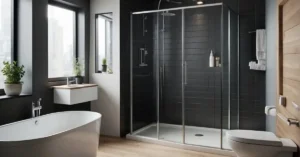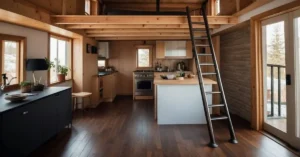Essentials of Tiny House Wet Room Designs
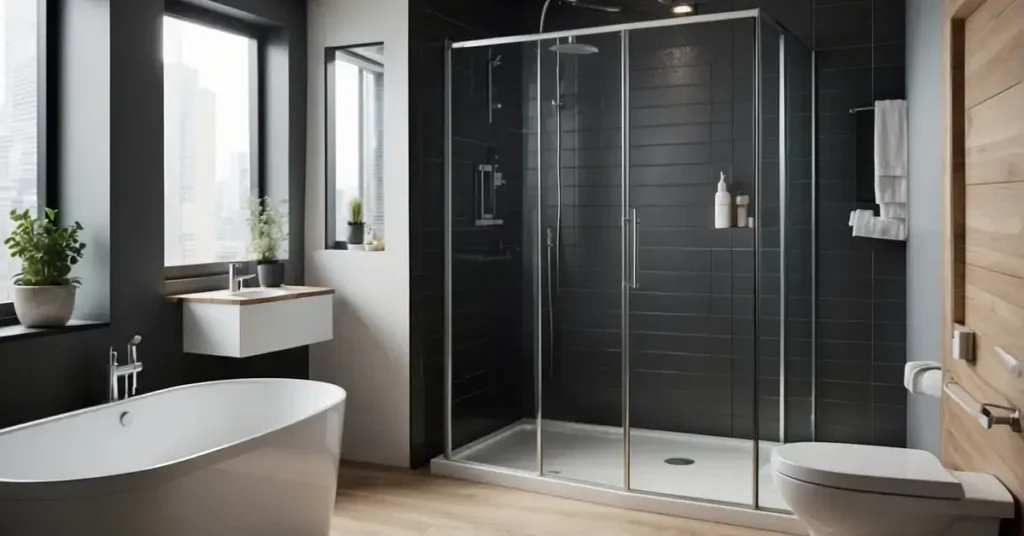
When designing a tiny house wet room, maximizing space while ensuring functionality is crucial. Here are the essentials to consider:
Space Utilization: In a wet room, every inch matters. Designers often recommend a space-saving layout that merges the shower, toilet, and sink into a single waterproof area. This design increases efficiency and opens up the rest of the living space.
Waterproofing: It’s vital to use waterproof materials for the floors and walls. Quality waterproofing ensures that water from the shower doesn’t damage the structure of the tiny house. One might consider polished plaster for its seamless and moisture-resistant properties.
Drainage: A well-designed drainage system is non-negotiable. The floor should be slightly sloped towards the drain to prevent water buildup and facilitate quick drainage.
Ventilation: Proper ventilation is required to manage humidity and prevent mold growth. This could mean installing a high-quality vent or a small window.
Lighting: Since wet rooms are compact, strategic lighting is essential. It can make the space appear larger and more inviting. Opt for options that are safe for wet environments.
Storage Solutions: To avoid clutter, built-in shelves or wall-mounted baskets can be quite handy. They should be placed in areas that will remain relatively dry.
Accessibility: Accessibility features such as grab bars or a seat in the shower can enhance safety and comfort.
One can explore various tiny house wet bathroom ideas to customize their space to their liking, keeping in mind that the essentials of practicality and simplicity guide the design process.
✅ Moisture Resistant
✅ Non-Toxic
✅ Also available in Black
❌ Graphic Marble Design
What Amazon Customers say:
💫 "They are beautiful and great compliment to bathroom vanities."
💫 "Love the product it fits perfectly in my guest bathroom"
💫 "Love that these are not metal or stone, so easy to clean."
Space Optimization Strategies
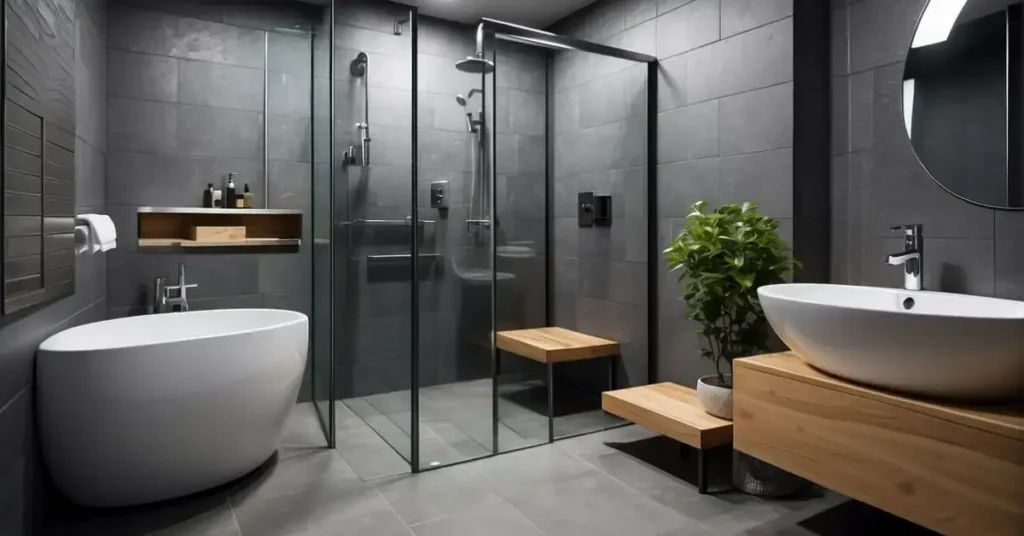
When designing a tiny house wet room, the primary focus is on maximizing the available space while maintaining functionality and aesthetic appeal. The strategies outlined here are critical for tiny homeowners to create a balance between efficient space use and a comfortable bathroom experience.
Multifunctional Fixtures
In tiny house wet rooms, choosing fixtures that serve multiple purposes is essential. For instance, a sink with a cabinet beneath can provide both a washing station and a storage space. Wall-mounted toilets with hidden tanks save floor space, and foldable shower seats can be tucked away when not in use. These fixtures contribute to the overall space-saving goal and leave more room available for movement.
Built-In Storage Solutions
Incorporating built-in storage helps reduce clutter and keeps the wet room organized. The success of such storage options lies in their subtlety and integration into the wet room’s design. Recessed shelves, also known as niches, in shower walls are perfect for holding toiletries without encroaching on the shower space. Another strategy is using the normally empty space above the toilet or door for additional cabinetry or open shelving. The aim is to provide adequate storage while maintaining a streamlined look.
Wet Room Layout Ideas
The layout of a wet room is paramount in enhancing its functionality. Placing the shower area at the far end of the room can create a more open feel, especially when paired with a clear glass partition or curtain that can be moved aside when not in use. A key layout strategy is the ‘corner approach,’ which involves situating the toilet and sink on adjacent walls to free up the opposite corner for the shower, making practical use of every square inch. Proper drainage is also integral and should be planned for in the layout, with the floor sloping gently towards a central drain.
Materials and Surfaces
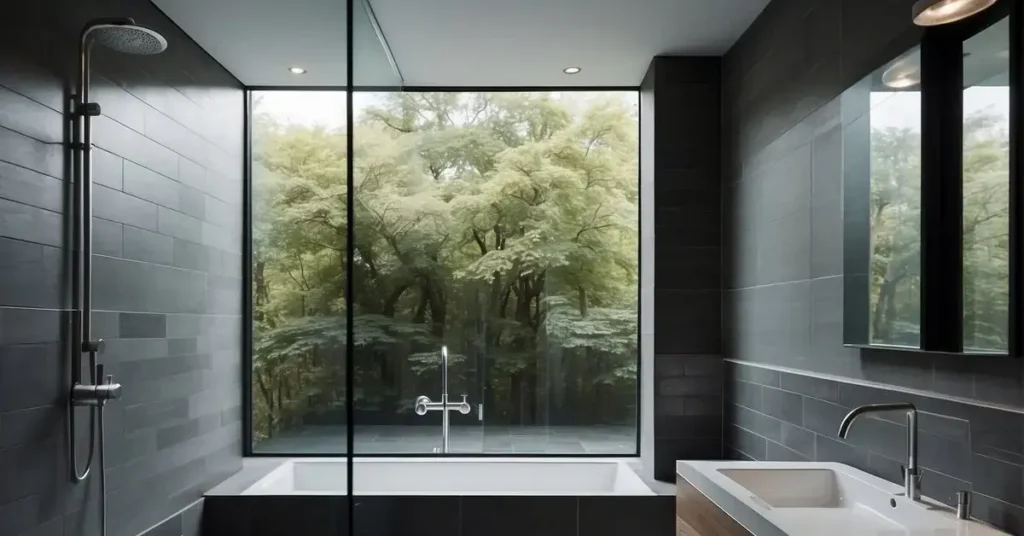
When designing a tiny house wet room, selecting the right materials and surfaces is crucial for both functionality and aesthetics. They need to be robust enough to handle high moisture, while also contributing to the overall look and feel of the space.
Waterproofing Essentials
Waterproof Membranes: A critical foundation for wet room durability is the application of waterproof membranes beneath tiles or wall finishes. These are essential to prevent water seepage and protect the building structure.
Sealants: Around fixtures and fittings, it’s vital to use quality silicone sealants to ensure watertight joints and prevent leaks.
Flooring and Wall Choices
Tiles: Ceramic or porcelain tiles are popular choices for both walls and floors in wet rooms due to their water-resistant properties and ease of cleaning.
Polished Plaster: For a seamless look, polished plaster can be an excellent wall finish, as it creates a waterproof surface that’s both stylish and practical.
Eco-Friendly Materials
Recycled Glass Tiles: These offer an environmentally friendly option for wet room surfaces, adding unique style while also being resistant to mold and mildew.
Bamboo Flooring: As a sustainable choice, bamboo flooring can be treated for enhanced water resistance, making it suitable for wet room applications.
Lighting and Ventilation

In tiny house wet room designs, incorporating effective lighting and ventilation is crucial to creating a functional and pleasant space. They ensure one’s bathroom is comfortable, mold-free, and visually appealing.
Natural Light Maximization
Maximizing natural light can make a wet room feel more spacious and inviting. Skylights and frosted windows allow for privacy while bringing in an abundance of daylight. Incorporating mirrored surfaces can further reflect light throughout the space, enhancing the natural illumination.
Artificial Lighting Options
For artificial lighting, LED recessed lights are a popular, energy-efficient choice that provide ample brightness without intruding on the limited space. One can also consider waterproof LED strips that add a modern touch and can be placed in niches or under shelves for a layered lighting effect.
Effective Ventilation Systems
Proper ventilation is non-negotiable in a tiny house wet room to prevent moisture damage and maintain air quality. The installation of a high-quality exhaust fan, ideally with a humidity sensor, can help to automatically regulate the moisture levels. Good ventilation not only protects the structure but also supports a healthy living environment by preventing mold and mildew growth.
Decor and Accessories
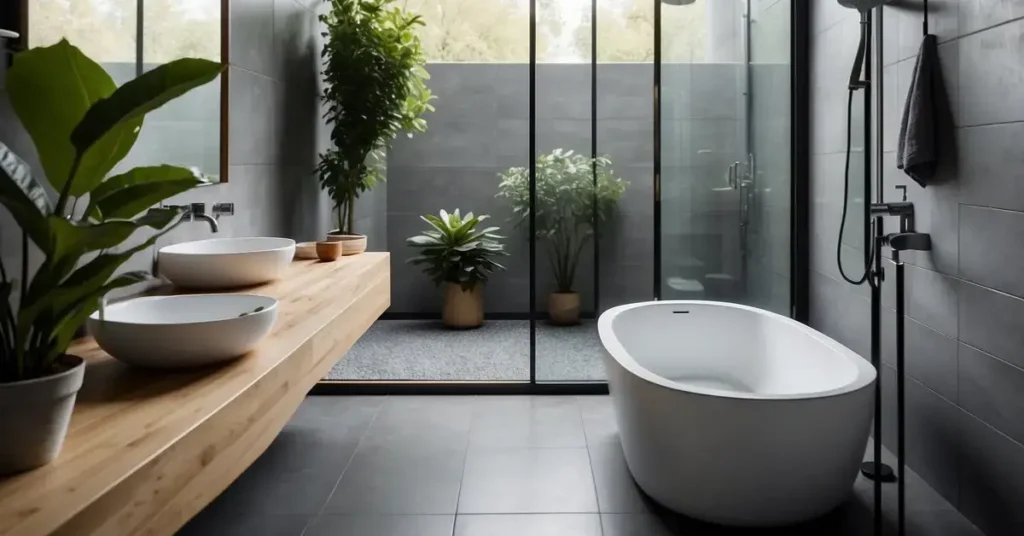
When designing a tiny house wet room, the decor and accessories chosen play a significant role in both functionality and aesthetic. Careful selection can make these small spaces feel welcoming and larger than they are.
Color Schemes and Textiles
Choosing the right color scheme for a tiny wet room can greatly influence its appearance. Light, neutral colors like whites or soft pastels expand the perception of space, while vibrant accents can add personality. Hygienic and seamless plaster is gaining popularity, as it’s waterproof and joint-free. Complementary textiles such as towels and mats should be quick-drying and mildew-resistant to maintain a clean and fresh look.
Mirrors and Glass Features
Mirrors are pivotal in tiny wet room design. They reflect light and the visual of open space, creating a sense of depth. Sleek, frameless mirrors or even an antique mirror can serve as a stunning focal point. Glass features, like a transparent shower divider, maintain an open concept feel and allow light to flow throughout the space unobstructed.
Towel Racks and Niches
The use of towel racks and niches is essential for storage without clutter. Wall-mounted racks or heated towel bars keep towels dry and serve a dual purpose as a cozy luxury. Built-in wall niches offer a recessed spot for toiletries. They keep surfaces clear and contribute to the streamlined, organized aesthetic essential in a tiny wet room.
Inspirations
Concrete Wet Room

Wet room with Wooden Elements

Grey Wet room with Wooden Elements

Beige Big Wet room

Wet room with Wooden Bathtub

Wet room with Wooden Floor

Wood and Concrete Wet room

Wet room with small White Tiles

Wet room with wall

Dark noble Wet room

If you prefer to get inspiration from a video, I recommend this one:
How do you stop water going everywhere in a wet room?
To stop water from going everywhere in a wet room, install a higher flow drain, ensure the floor is properly sloped towards the drain, and use water-resistant materials like waterproof membranes for the walls and floors.
What are the disadvantages of a wet room?
Disadvantages of a wet room include potential for water leakage, higher installation costs due to waterproofing requirements, and the possibility of the entire room getting wet after use, which can be inconvenient.
What is the smallest wetroom possible?
The smallest practical wet room size is about 1.5m x 1m, which can accommodate a toilet and wash basin. The minimum recommended size for the shower area itself is usually 800mm x 800mm.
If you liked this blog article about the topic “Tiny House Wet Room Designs”, don’t forget to leave us a comment down below to tell us about your experience.
Not enough inspiration yet?
Feel free to also check out our other Articles from the category “Tiny House“ and don’t forget to follow us on Pinterest.

